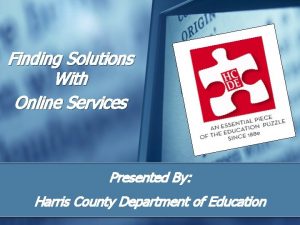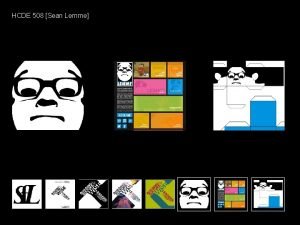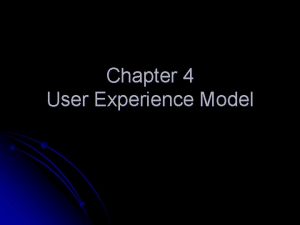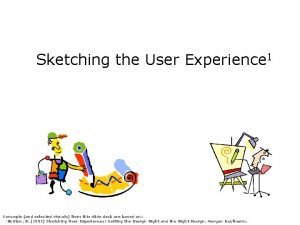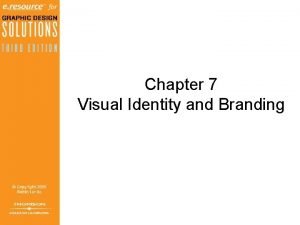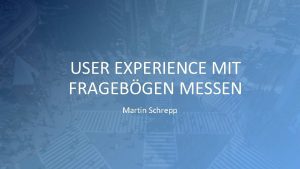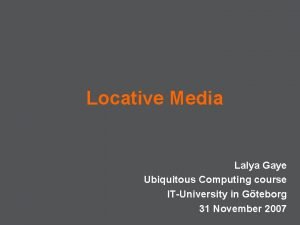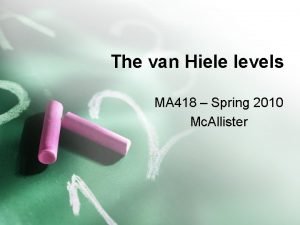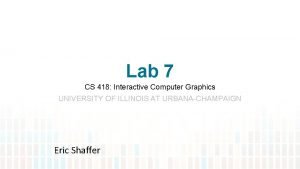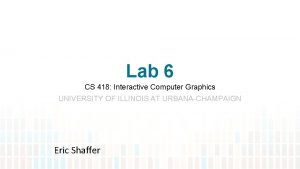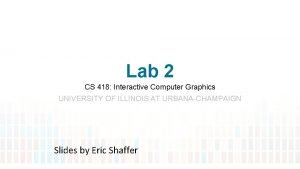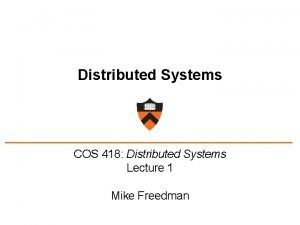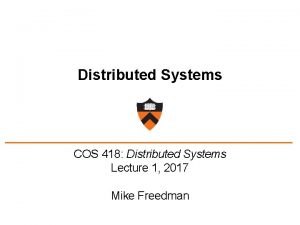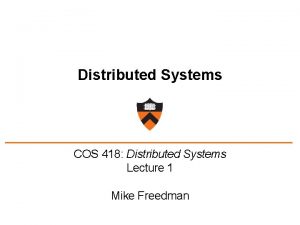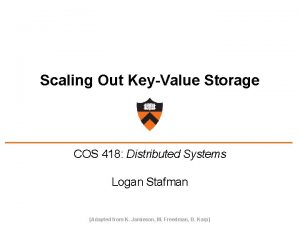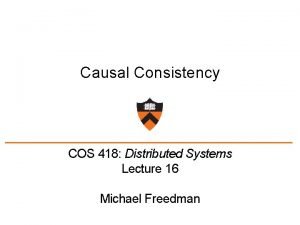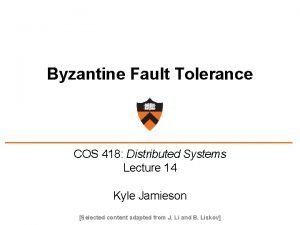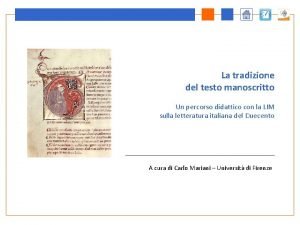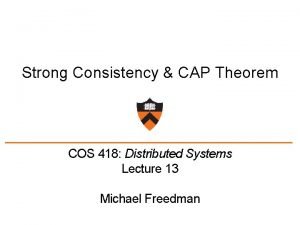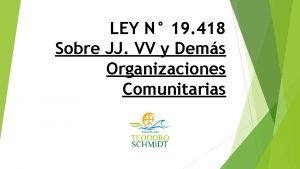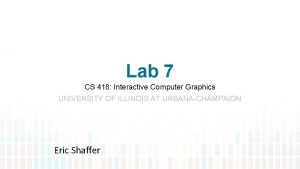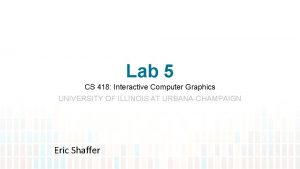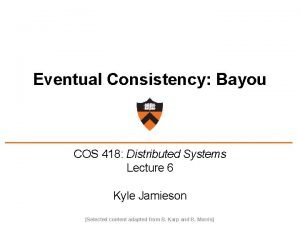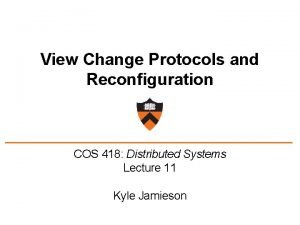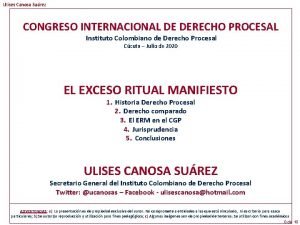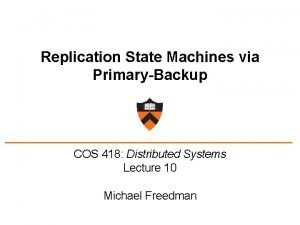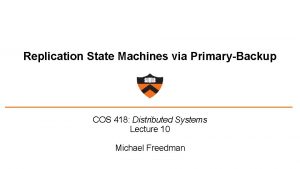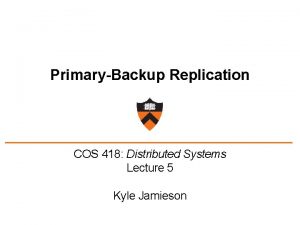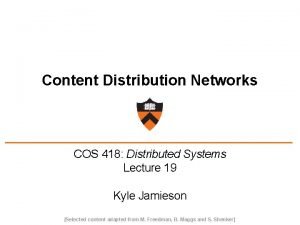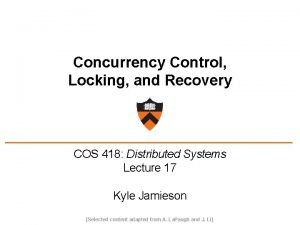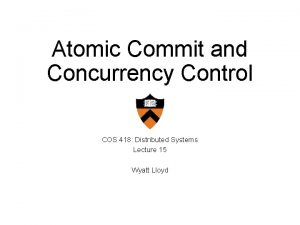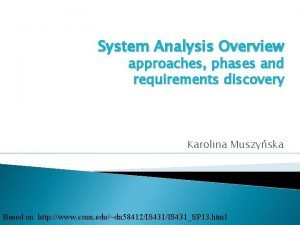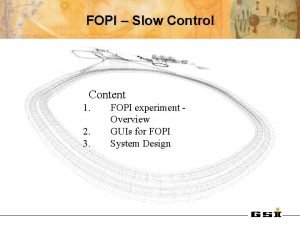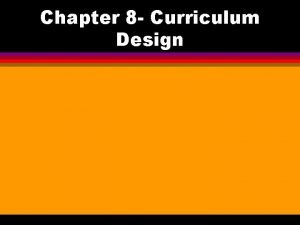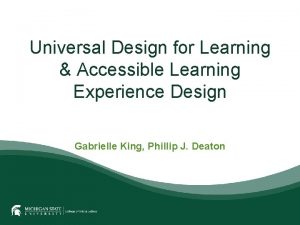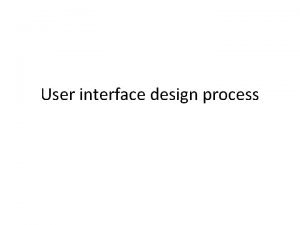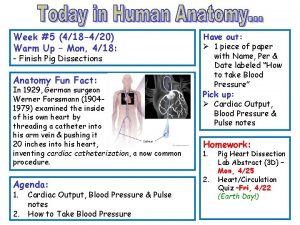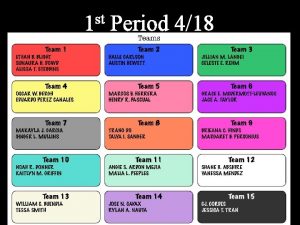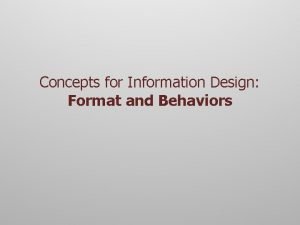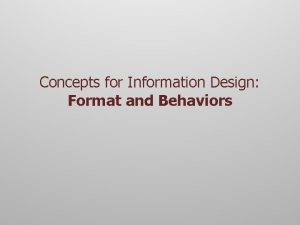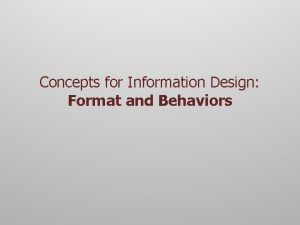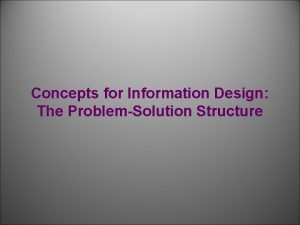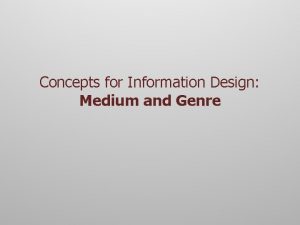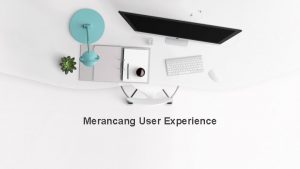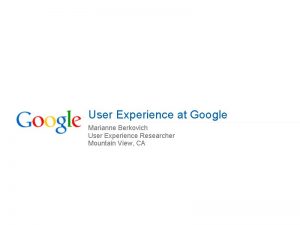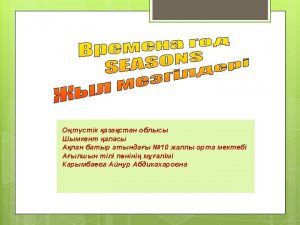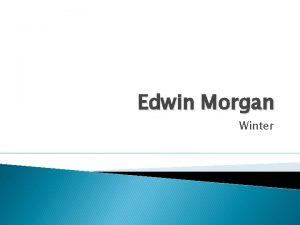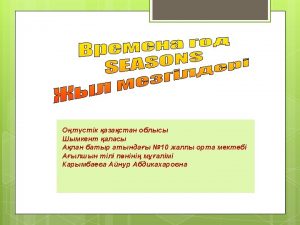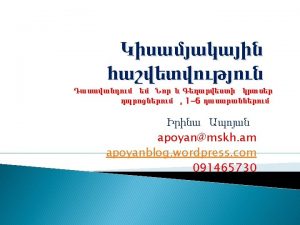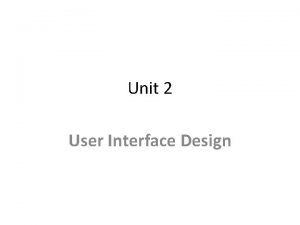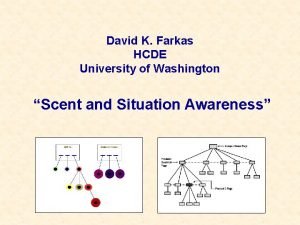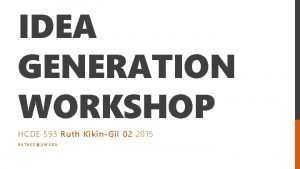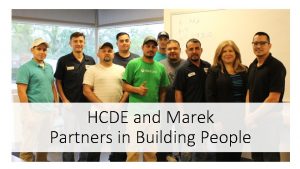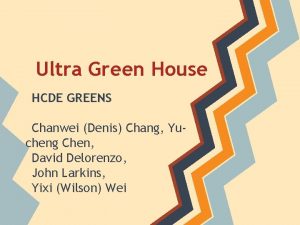User Experience Design Overview HCDE 418 Winter 2014




















































- Slides: 52

User Experience Design Overview HCDE 418 Winter 2014 University of Washington HCDE 418

Agenda Announcements Introductions Questions on syllabus Lecture & Discussion – What is User Experience Design? Break Lecture & Discussion – Design Process Next class University of Washington HCDE 418

Announcements R 1 due now R 2 due next Monday A 1 and S 1 due next Wednesday University of Washington HCDE 418

Introduction - Instructor Julie Kientz (pronounced like “Keentz”) § Please call me Julie! § Assistant Professor in HCDE § Ph. D. in Computer Science from Georgia Tech Research in Human-Computer Interaction § Computing for Healthy Living & Learning (CHi. LL) Personal Interests: Playing with my daughter, Travel, Skiing, Running & Fitness, Pets (have 1 dog, 2 cats), Volunteering, Reading, Games University of Washington HCDE 418

Introduction - TA Jonathan Cook § Also goes by Jon § MDes. student in Interaction Design (Ix. D) in the Division of Design in the School of Art Design interests: Personal Interests: University of Washington HCDE 418

LECTURE & DISCUSSION – UX DESIGN OVERVIEW University of Washington HCDE 418

What is Design? Creative endeavor Process of creating or shaping tools or artifacts for direct human use Outputs are things people-centered concerns Processes, methods University of Washington HCDE 418

Characteristics of Design… § § § § is conscious keeps human concerns in the center is a conversation with materials is creative is communication has social implications is a social activity University of Washington HCDE 418

Design vs. Engineering § § § Make a mostly-known outcome possible Construct a sturdy bridge based on specifications Concerned with what can be done Reliance on well-established formulae Humans may or may not be directly “in the loop” Design § Envision new possibilities, new outcomes § Determine what outcome should result among infinite possibilities § Reliance on process over formulae § Humans are central actors “in the loop” University of Washington HCDE 418

Design vs. Art Design (as we regard it) concerns the creation of something useful and usable Art does not bother with this restriction § The test: how to deem what is “good”? University of Washington HCDE 418

What is User Experience? Take two minutes to write down a definition in your own words University of Washington HCDE 418

User Experience Definitions "User experience" encompasses all aspects of the end-user's interaction with the company, its services, and its products. ” “The first requirement for an exemplary user experience is to meet the exact needs of the customer, without fuss or bother. Next comes simplicity and elegance that produce products that are a joy to own, a joy to use. True user experience goes far beyond giving customers what they say they want, or providing checklist features. -Nielsen-Norman Group University of Washington HCDE 418

UX vs. Usability Evaluation of understandability vs. holistic design Designing it right vs. the right design Often, poor usability leads to a bad user experience, but not necessarily University of Washington HCDE 418

UX vs. User-Centered Design More similarly related – user experience design is an activity that follows a usercentered design process University of Washington HCDE 418

Other Contrasts Interface vs. interaction design § Artifact versus sequence § Graphic < interface < interaction < user experience design vs. Design § design: the general activity we've been talking about so far § Design: the formal field, including theory, methods, literature, and practice University of Washington HCDE 418

Who Does Design? Designers! § § Interface designers Interaction designers Industrial designers Graphic designers are also often: § § § Applied anthropologists Design ethnographers Social psychologists Cognitive psychologists Experimental psychologists Computer scientists Engineers Information architects Usability professionals Technical writers Dramatists University of Washington HCDE 418

Can Anyone be a Designer? Don Norman says “yes” § Mostly in the “design” sense Bill Buxton says “no” § Mostly in the “Design” sense Not really a clear consensus on this University of Washington HCDE 418

University of Washington HCDE 418

What is Designed? “Look around you. The only thing not designed is Nature. ” § David Kelley Anything consciously intended for human use is designed § Often poorly, though, which is where user experience design comes in University of Washington HCDE 418

What is Designed in UX? Artifact view: The object, device, or system that is designed Holistic view: The interaction, the flow, the user's experience are all designed § § § § all potential users (often > 1) all other stakeholders manuals tutorials help systems customer support what else? Think in terms of users' goals § Artifacts have no goals § People have goals! § Keep users in the center in the beginning, middle, and end University of Washington HCDE 418

Why is Design Hard? Experience design is multidisciplinary Judging/predicting which designs will be successful and which will not is difficult It is simply hard to come up with good solutions § The space of “the possible” is vast compared to the space of “the good” University of Washington HCDE 418

Why is Design Hard? All design involves making tradeoffs § Can't maximize everything Good designs are non-obvious Humans are unpredictable Humans make errors Design relies on process expertise, not knowledge expertise University of Washington HCDE 418

Core Skills of Design To synthesize a solution from all of the relevant constraints, understanding everything that will make a difference to the result To frame, or reframe, the problem and objective To create and envision alternatives. To select from those alternatives, knowing intuitively how to choose the best approach. To visualize and prototype the intended solution University of Washington HCDE 418

Sketches on Design Thinking (Andy Ko) University of Washington HCDE 418

Design is Not Just “Lipstick on a Pig” Not just changing how things look Or making things pretty Or designing graphics University of Washington HCDE 418

UX Design Mantras “The user is not like me. ” –Don Norman “The best way to have good ideas is to have lots of ideas. ” – Linus Pauling “Fail often to succeed sooner. ” – IDEO “Enlightened trial-and-error succeeds over the careful planning of the lone genius. ” – IDEO University of Washington HCDE 418

“The user is not like me” Why not? § Designers are much more familiar with the interface and with the problems being solved than users. § Designers are confident. Users are often fearful. § Designers work in settings that are different than the context in which the product may be used. § Designers may have different skills than users (e. g. , perceptual, cognitive, or domain skills). § (from Don Norman) University of Washington HCDE 418

A 1: Thinking about UX Design Think about the objects with which you experience and how they're designed § Derive design principles Assignment description posted on Canvas (A 1) § Due Wednesday, 1/15/14 University of Washington HCDE 418

BREAK – 5 MINUTES University of Washington HCDE 418

LECTURE & DISCUSSION UX DESIGN PROCESS University of Washington HCDE 418

Why a Design Process? It helps us get started with a proven tack It prevents “designer's block” It keeps us directed toward a final product It helps us stay on schedule and within cost It helps us measure design progress It helps us communicate where we are to others It prevents us from omitting important steps It is more reliable than intuition It forces us to iterate! It helps us keep the user first! University of Washington HCDE 418

Designers' Expertise… …lies not in the thing he or she is designing § e. g. , shopping carts, cell phones, pencils You do not have to be a health expert to be a designer of a personal health record portal § In fact, if you were, it would probably stifle you (Why? ) § These people suffer from their expert blind spots § Think of helping your grandparents with computers – it’s hard to explain things when you know to much about it Instead, you must be an expert in the process of design University of Washington HCDE 418

Design Process? NO! WRONG! University of Washington HCDE 418

Design Requires Iteration University of Washington HCDE 418

Stage Goals • Generate lots of ideas • Grasp issues and potential solutions • Learn about stakeholders • Discover goals and needs • How is it done now? • What is wanted? • What else has been tried? • Build final product • Ramp up marketing, support, and maintenance • Discover problems • Assess progress • Determine next steps University of Washington • Produce something tangible • Identify challenges • Uncover subtleties HCDE 418

Design Processes There is no agreement on an exact design process For each process shown § § What do you like about it? What do you not like about it? What is missing? What is superfluous? University of Washington HCDE 418

Moggridge '07 Process What do you like about it? What do you not like about it? What is missing? What is superfluous? University of Washington HCDE 418

Buxton’s Design Process What do you like about it? What do you not like about i What is missing? What is superfluous? University of Washington HCDE 418

Idea Generation Process What do you like about it? What do you not like about it? What is missing? What is superfluous? University of Washington HCDE 418

Laseau’s Funnel ‘ 80 What do you like about it? What do you not like about it? What is missing? What is superfluous? University of Washington HCDE 418

ISO 13407 University of Washington What do you like about it? What do you not like about it? What is missing? What is superfluous? HCDE 418

ISO 9241 -210 What do you like about it? What do you not like about it? What is missing? What is superfluous? Replaced ISO 13407 University of Washington HCDE 418

Dix '04 Process University of Washington What do you like about it? What do you not like about it? What is missing? What is superfluous? HCDE 418

Simplified View University of Washington What do you like about it? What do you not like about it? What is missing? What is superfluous? HCDE 418

What do you like about it? What do you not like about it? What is missing? What is superfluous? Very Simplified View University of Washington HCDE 418

Apple’s Process University of Washington What do you like about it? What do you not like about it? What is missing? What is superfluous? HCDE 418

Comparing the Processes What do they all have in common? What seem to be the main components? University of Washington HCDE 418

What about Engineering? What about writing production-level code or constructing working products? What about quality assurance (QA)? § Bug fixing? § Feature requests? § Feature creep? The design process and the engineering processes must work together University of Washington HCDE 418

Summary UX Design is a highly iterative process Design processes must keep the user’s interests central UX Design starts with understanding the user Designs are never truly perfect - They can always be improved. § It is a skill to know when to stop iterating and call a design “finished” University of Washington HCDE 418

IDEO's Deep Dive Classic example of the user-centered design process IDEO's Deep Dive Video Part 1: http: //www. youtube. com/watch? v=oo. N 05 Q 030 Qo Part 2: http: //www. youtube. com/watch? v=_7_s. Zy-kusw Part 3: http: //www. youtube. com/watch? v=Fx. O 8 t 9 Sonk 8 University of Washington HCDE 418

Discussion University of Washington HCDE 418

Next Class Topics Monday, January 13 th § Design Methods 1: Look & Ask Upcoming Work § R 2 Reading Reflection § Assignment 1 § Sketching Project 1 due in Week 3 University of Washington HCDE 418
 Hcde portal hcde-texas
Hcde portal hcde-texas Canvas hcde
Canvas hcde Hcde 508
Hcde 508 Winter kommt winter kommt flocken fallen nieder
Winter kommt winter kommt flocken fallen nieder Es ist kalt es ist kalt flocken fallen nieder
Es ist kalt es ist kalt flocken fallen nieder Meine lieblingsjahreszeit ist der winter
Meine lieblingsjahreszeit ist der winter Imprinting psychology
Imprinting psychology Early experience vs. later experience
Early experience vs. later experience Indirect experience
Indirect experience User experience model
User experience model Sketching the user experience
Sketching the user experience User experience
User experience Wie wertet man einen fragebogen aus
Wie wertet man einen fragebogen aus Lalya gaye
Lalya gaye User interface design in system analysis and design
User interface design in system analysis and design Define output design
Define output design Single user and multiple user operating system
Single user and multiple user operating system Rtos multitasking
Rtos multitasking Ma-418-0-0-4
Ma-418-0-0-4 Cmu 15-418
Cmu 15-418 Cs 418 interactive computer graphics
Cs 418 interactive computer graphics Cs 418 uiuc
Cs 418 uiuc Glcreatebuffer
Glcreatebuffer Cos418
Cos418 Cos418
Cos418 Cos 418
Cos 418 Cos 418
Cos 418 Cos 418
Cos 418 Cos 418
Cos 418 Codice palatino 418
Codice palatino 418 Cos418
Cos418 Ley 19 418
Ley 19 418 Cs 418 interactive computer graphics
Cs 418 interactive computer graphics Cs 418 interactive computer graphics
Cs 418 interactive computer graphics Bayou distributed system
Bayou distributed system Cos 418 spring 2021
Cos 418 spring 2021 Cos 418
Cos 418 Sentencia su-418/19
Sentencia su-418/19 Cos418
Cos418 Primary backup replication
Primary backup replication Cos 418
Cos 418 Cos418
Cos418 Cos 418
Cos 418 Cos 418
Cos 418 Cos 418
Cos 418 System design overview
System design overview System design overview
System design overview L
L Accessible learning experience design and implementation
Accessible learning experience design and implementation Basic principles of input design
Basic principles of input design User interface design cycle
User interface design cycle User interface design steps in software engineering
User interface design steps in software engineering User interface analysis and design
User interface analysis and design
